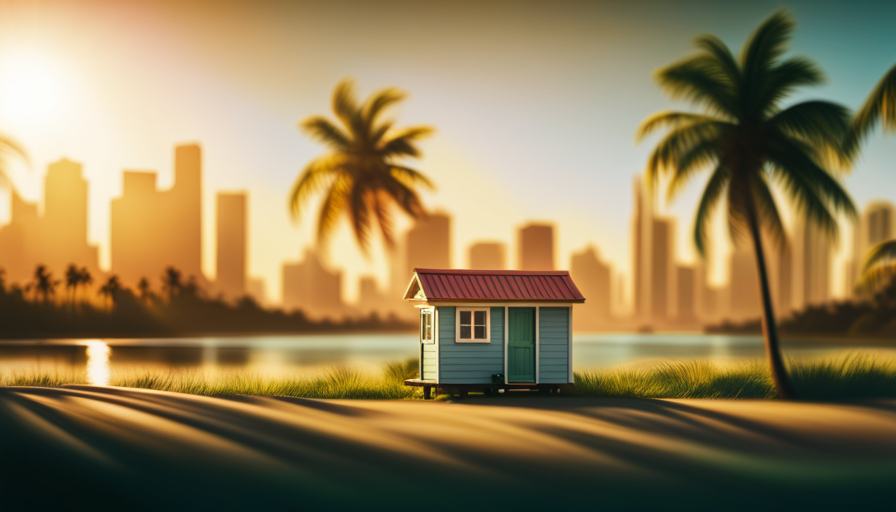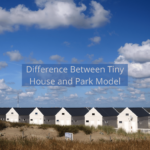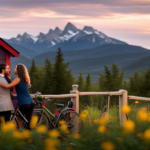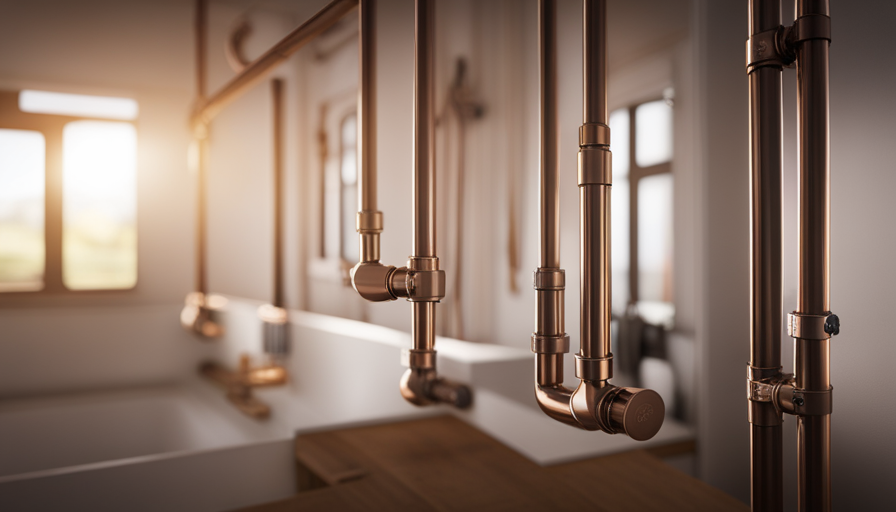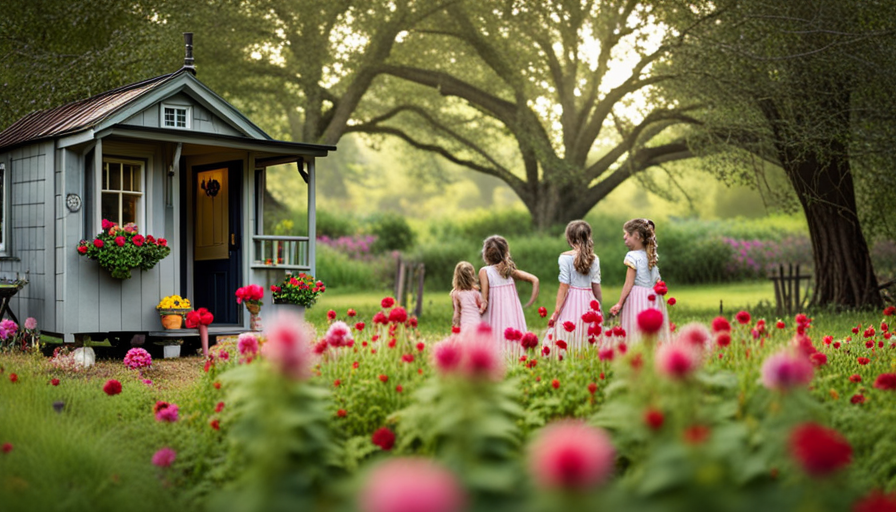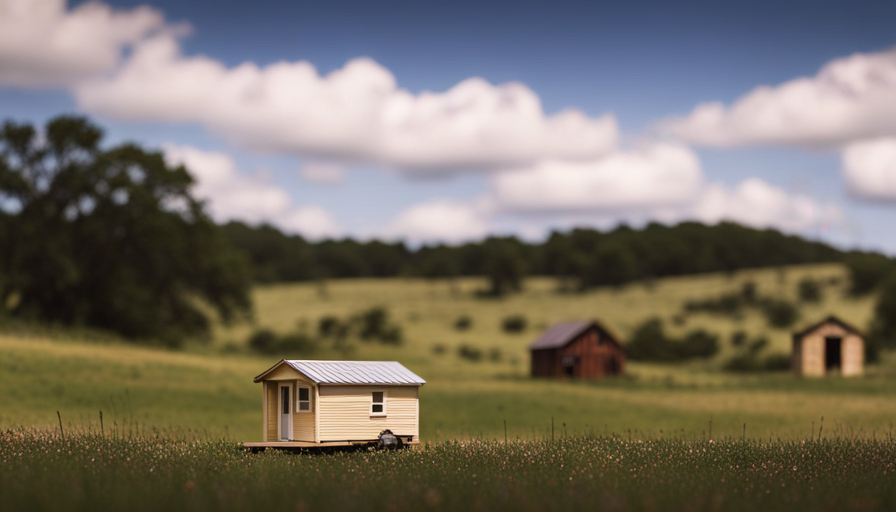Hi there! Are you in search of a tiny house on wheels? Well, you’ve come to the right place. Let me tell you, the world of tiny houses is full of excitement. It provides all the comforts of a traditional living space, just in a smaller package. And just FYI, this industry is growing rapidly.
Now, before we dive into the nitty-gritty of where to find your dream tiny house, let’s take a moment to appreciate the irony of it all. We live in a society that’s obsessed with bigger, better, and more, yet here we are, seeking the simplicity and freedom that comes with living in a tiny house.
But fear not, my fellow tiny house enthusiasts, for I am here to guide you on your quest to find the perfect tiny abode. From online listings to workshops, social media groups to real estate websites, there’s a plethora of options out there just waiting for you to explore.
So buckle up, my friend, and let’s embark on this tiny adventure together.
Key Takeaways
- Online listings and marketplaces are a great resource for finding a tiny house on wheels.
- Contact professional builders who specialize in tiny houses on wheels for personalized assistance.
- Check local classifieds and real estate websites for additional options.
- Tiny house expos and festivals offer a wide range of tiny houses on display for inspiration and insights into tiny house living.
Research Online Listings and Marketplaces
Looking to buy a tiny house on wheels? Check out online listings and marketplaces for the best deals! When it comes to finding the perfect tiny house, the internet is your best friend.
Online listings and marketplaces offer a wide range of options, making it easy to find the tiny house of your dreams.
One important factor to consider when searching online is tiny house financing. Many sellers offer financing options, allowing you to spread out the cost over time. This can make owning a tiny house more affordable and accessible. Be sure to explore different financing options and compare interest rates to find the best deal for you.
Additionally, it’s crucial to consider tiny house zoning regulations. Before making a purchase, check the zoning laws in your area to ensure you can legally park and live in a tiny house on wheels. Some areas have specific regulations regarding the minimum size of dwellings or where you can park your tiny house. Understanding these regulations will save you time and potential legal issues down the road.
Now that you know how to navigate online listings and marketplaces, let’s move on to the next step: visiting tiny house workshops and events. These events are a great opportunity to see different models in person and talk to experts in the tiny house community.
Visit Tiny House Workshops and Events
Attending tiny house workshops and events is a great way to immerse yourself in the world of mobile living spaces on wheels. Not only do these events provide an opportunity to learn about the latest trends and innovations in tiny house design, but they also offer a chance to connect with like-minded individuals who are passionate about tiny living.
Here are four reasons why attending workshops and events should be on your to-do list:
-
Hands-on Experience: Workshops often provide hands-on experience in building and designing tiny houses, allowing you to learn practical skills that can be applied to your own project.
-
Expert Advice: Events often feature speakers and panel discussions with experts in the field of tiny house design, construction, and financing. This valuable advice can help you make informed decisions throughout the process.
-
Networking Opportunities: Workshops and events bring together a community of tiny house enthusiasts, builders, and designers. This networking can lead to valuable connections, partnerships, and even potential opportunities to purchase or rent a tiny house.
-
Tiny House Financing: Many workshops and events also offer sessions on tiny house financing, providing insights on how to secure funding for your project.
Attending these workshops and events will give you a comprehensive understanding of the tiny house movement and connect you with individuals who can offer guidance and support. After exploring the world of tiny houses through workshops and events, it’s time to delve into social media groups and forums to further expand your knowledge and connect with the tiny house community.
Explore Social Media Groups and Forums
Immerse yourself in the vibrant world of mobile living spaces by joining social media groups and forums. You can connect with a community of passionate individuals who share their unique experiences and creative ideas for compact and innovative homes on wheels.
Social media groups and online forums provide an excellent platform for tiny house enthusiasts to come together, discuss their projects, and exchange valuable information. In these groups, you can find a wealth of knowledge about where to buy a tiny house on wheels. Members often share their personal recommendations and experiences, including reputable builders, reliable suppliers, and affordable options. You can ask questions, seek advice, and gain insights from people who have already gone through the process of buying a tiny house.
Furthermore, social media groups and forums are a great place to discover upcoming workshops, events, and gatherings dedicated to tiny houses. These events provide an opportunity to learn from experts, meet like-minded individuals, and even tour different models of tiny houses. By participating in these events, you can expand your network and get firsthand experience with various designs and features.
By immersing yourself in these online communities, you will gain a deeper understanding of the tiny house movement and find valuable resources to guide you in your search for a tiny house on wheels. Once you feel ready to take the next step, you can easily transition into contacting tiny house builders for more personalized assistance.
Contact Tiny House Builders
If you’re interested in buying a tiny house on wheels, it’s a good idea to reach out to professional builders who specialize in this type of construction. They have the expertise and experience to create a high-quality and functional living space.
When you contact them, don’t forget to inquire about their current inventory or custom design options, so you can find the perfect tiny house that suits your needs and preferences.
Reach out to professional builders who specialize in tiny homes on wheels
To find where you can buy a tiny house on wheels, connect with expert builders who specialize in these unique homes. They have the knowledge and experience to craft a tiny house that meets your specific needs and preferences. Here are five reasons why reaching out to professional builders is a great idea:
-
They can provide you with information on tiny house financing options, helping you navigate the financial aspect of purchasing a tiny house.
-
They can guide you through the pros and cons of building vs buying a tiny house, helping you make an informed decision.
-
They have a wealth of knowledge about building codes and regulations, ensuring that your tiny house is compliant and safe.
-
They can offer advice on design and layout options, helping you create a space that maximizes functionality and comfort.
-
They may have an inventory of pre-built tiny houses or can custom design a tiny house to fit your specific needs.
Reaching out to professional builders is a crucial step in finding your dream tiny house on wheels. Inquire about their current inventory or custom design options to get started on your journey to tiny house living.
Inquire about their current inventory or custom design options
Check out what professional builders have in stock or see if they can create a custom design that matches your unique preferences and needs. When reaching out to these builders, it’s important to inquire about their current inventory or custom design options.
Many professional builders who specialize in tiny homes on wheels have a variety of models already built and ready for purchase. However, if you have specific requirements or a vision in mind, they can also guide you through the custom design process. They’ll work closely with you to ensure that every detail is tailored to your liking. Additionally, professional builders often have financing options available to help make your dream of owning a tiny house on wheels a reality.
Once you have explored these options, it’s time to check local classifieds and real estate websites to widen your search for the perfect tiny house.
Check Local Classifieds and Real Estate Websites
One popular option for finding a tiny house on wheels is browsing through local classifieds or real estate websites, where you can often find a variety of listings available. These platforms provide a convenient way to explore different options in your area and compare prices, sizes, and designs.
Additionally, you can find information on tiny house financing and zoning regulations, which are crucial considerations when purchasing a tiny house.
When searching through local classifieds and real estate websites, it’s important to be thorough and take your time. Look for listings that include detailed descriptions, high-quality photos, and contact information. Reach out to the sellers to inquire about the specific details of the tiny house, such as its size, construction materials, and any customizations that have been made. Some sellers may also offer custom design options, allowing you to personalize your tiny house to fit your needs and preferences.
As you browse through these listings, keep in mind that attending tiny house expos and festivals can also be a great way to explore different options and connect with builders, designers, and fellow tiny house enthusiasts. These events often feature a wide range of tiny houses on display, providing inspiration and valuable insights into the world of tiny house living.
So, after checking out local classifieds and real estate websites, consider attending a tiny house expo or festival to further expand your knowledge and options.
Attend Tiny House Expos and Festivals
Attending tiny house expos and festivals offers an exciting opportunity to immerse yourself in the world of compact living and connect with like-minded individuals. These events provide a platform for tiny house enthusiasts to showcase their unique creations, allowing you to explore a variety of tiny house designs and gather inspiration for your own dream home on wheels.
One of the major benefits of attending these expos and festivals is the access to tiny house financing options. Many exhibitors offer information on financing options specifically tailored for tiny homes, which can be a game-changer for those looking to purchase their own tiny house. Whether you’re interested in traditional financing or alternative options like personal loans or crowdfunding, these events provide a wealth of knowledge and resources to help you make your tiny house dreams a reality.
Additionally, attending these events allows you to meet and network with experts in the tiny house industry. You can learn from experienced builders, designers, and consultants who can guide you through the process of designing and constructing your own tiny home. By connecting with these professionals, you can gain valuable insights and advice that can save you time, money, and frustration.
Transitioning into the next section, collaborating with a tiny house consultant can further enhance your journey towards owning a tiny house.
Collaborate with a Tiny House Consultant
Partnering with a tiny house consultant is like having a skilled navigator guiding you through the uncharted waters of creating your own compact haven. These experts are well-versed in the intricacies of tiny house living and can provide invaluable guidance throughout the entire process. From finding the perfect design to navigating zoning regulations, a consultant can help you make informed decisions and avoid costly mistakes.
One of the key benefits of collaborating with a tiny house consultant is their wealth of knowledge and experience. They have likely worked with numerous clients and can offer insights and recommendations based on their past projects. Additionally, they can help you identify your specific needs and preferences, ensuring that your tiny house is tailored to your unique lifestyle.
Finding a consultant is relatively easy, thanks to the growing popularity of the tiny house movement. You can search online directories, attend tiny house expos and festivals, or join online communities dedicated to tiny house living. When selecting a consultant, it’s important to consider their credentials, experience, and reputation. Reading client testimonials and reviews can also provide valuable insights into their expertise and professionalism.
Consider tiny house rentals or lease-to-own options for those who want to try out tiny house living before committing to a purchase. This allows you to experience the lifestyle firsthand and determine if it’s the right fit for you.
Consider Tiny House Rentals or Lease-to-Own Options
If you’re considering the idea of living in a tiny house but aren’t quite ready to commit to a purchase, exploring rental opportunities could be a great option for you. Renting allows you to experience the tiny house lifestyle firsthand and get a sense of whether it’s a good fit for you before making a long-term commitment.
Additionally, lease-to-own agreements can provide a pathway to gradually owning your own tiny house on wheels, allowing you to test the waters and build equity over time.
Don’t miss out on the chance to try out tiny house living and potentially make it a permanent part of your life!
Explore rental opportunities to experience tiny house living before committing to a purchase
Before diving into the world of tiny house ownership, why not dip your toes in by renting a tiny house on wheels and experiencing the unique lifestyle firsthand? Renting a tiny house can offer several benefits.
First, it gives you the opportunity to try out different layouts and designs without the commitment of a purchase. This allows you to test if tiny house living is truly for you before making a long-term investment.
Second, renting a tiny house usually includes utilities and maintenance costs, relieving you of the financial burden. Some rental options even come fully furnished, saving you the hassle of finding and buying furniture.
Lastly, renting a tiny house gives you the flexibility to relocate and explore different areas without being tied down to a specific location. This can be especially beneficial if you’re unsure about where you want to settle.
So, why not give it a try? Renting a tiny house can be a great way to experience the lifestyle and determine if it’s right for you before considering a lease-to-own agreement that allows you to gradually own your tiny house on wheels.
Look for lease-to-own agreements that allow you to gradually own your tiny house on wheels
Consider exploring lease-to-own agreements where you can gradually become the proud owner of your very own compact home on wheels. These lease arrangements provide a unique opportunity to experience the benefits of tiny house living while working towards eventual ownership.
With a lease-to-own agreement, you can live in the tiny house of your dreams and make monthly payments that go towards the purchase price. This allows you to save up and gradually take ownership of your tiny home, all while enjoying the freedom and flexibility that comes with living on wheels. It’s an ideal option for those who are not ready to commit to a large upfront payment or who want to test out the tiny house lifestyle before fully committing.
By taking advantage of these lease-to-own agreements, you can take the first step towards your future as a tiny house owner.
Now, let’s explore how you can connect with tiny house communities.
Connect with Tiny House Communities
Explore tiny house communities to immerse yourself in a vibrant world where charming homes on wheels are nestled amongst lush greenery and friendly neighbors gather for cozy bonfires under the starlit sky. These communities offer a unique opportunity to connect with like-minded individuals who share your passion for sustainable living and minimalist lifestyles.
Not only can you find a place to park your tiny house on wheels, but you can also tap into a wealth of knowledge and resources that will help you navigate the world of tiny house living.
One of the key benefits of joining a tiny house community is access to valuable information about tiny house financing options. Since purchasing a tiny house on wheels can be a significant investment, it’s important to explore different financing options to find the one that best fits your budget and goals. In a tiny house community, you can learn from others who have successfully navigated the financing process and gain insights into alternative financing methods such as lease-to-own agreements.
Additionally, living in a tiny house community provides a sense of belonging and support. You’ll have the opportunity to build lasting friendships with like-minded individuals who understand and appreciate the unique challenges and joys of tiny house living. These communities often organize events, workshops, and skill-sharing sessions, allowing you to expand your knowledge and learn new skills.
As you explore the world of tiny house communities, don’t be afraid to think outside the box. Consider unconventional locations such as rural areas, backyard communities, or even mobile tiny house villages. These alternative options can offer unique benefits and opportunities for community engagement.
Transitioning into the next section, let’s now explore how thinking outside the box can lead you to discover innovative ways to purchase a tiny house on wheels.
Think Outside the Box
When thinking outside the box, it’s fascinating to discover that the average size of a tiny house is just 400 square feet. These compact dwellings may be small in size, but they offer big possibilities for alternative living arrangements.
If you’re considering buying a tiny house on wheels, it’s important to explore out-of-the-box solutions that can enhance your experience and make the most of your limited space. Here are three ideas to get you started:
-
Multi-purpose Furniture: Maximize every inch of your tiny house by investing in furniture pieces that serve multiple functions. For example, a sofa that can also be used as a guest bed, or a dining table that can be converted into a workspace. This will help you make the most of your limited square footage.
-
Vertical Storage: Utilize the vertical space in your tiny house by incorporating shelves, hooks, and storage units that go up the walls. This will allow you to keep your belongings organized and easily accessible, without taking up valuable floor space.
-
Clever Design: Consider unique design elements that can optimize your tiny house living experience. This could include features like foldable walls to create flexible living spaces, or skylights to bring in natural light and make your small home feel more spacious.
By thinking outside the box and incorporating these out-of-the-box solutions, you can create a functional and comfortable living space in your tiny house on wheels.
Frequently Asked Questions
Are tiny houses on wheels legal to live in full-time?
Yes, tiny houses on wheels are legal to live in full-time in many places. They offer the freedom to live in various tiny house communities and provide benefits such as affordability, mobility, and a simpler, more sustainable lifestyle.
What are the financing options available for purchasing a tiny house on wheels?
When it comes to financing options for purchasing a tiny house on wheels, there are several loan options available. From personal loans to RV loans, you can find a financing solution that fits your needs and budget.
Can I customize the design and layout of a tiny house on wheels?
Yes, you can definitely customize the design and layout of a tiny house on wheels. There are numerous options available to personalize your space, ensuring it meets your unique needs and preferences. From choosing the materials to deciding the floor plan, the possibilities are endless.
Are there any restrictions on parking and zoning regulations for tiny houses on wheels?
There are parking regulations and zoning restrictions that you should consider when choosing a location for your tiny house on wheels. It’s important to research and comply with local laws to ensure a legal and hassle-free living experience.
Are there any additional costs or fees involved in owning a tiny house on wheels, such as insurance or maintenance?
Owning a tiny house on wheels does come with additional costs. There are insurance costs to consider for protecting your investment, as well as maintenance expenses to keep your home in good condition and ensure its longevity.
Conclusion
In conclusion, finding a tiny house on wheels can be an exciting and rewarding adventure. With a little research and exploration, you can discover the perfect tiny home that fits your needs and budget.
Did you know that the average cost of a tiny house on wheels is around $30,000? This statistic shows that living in a tiny house can be an affordable housing option for many people.
So why wait? Start your search today and join the growing community of tiny house enthusiasts!
Hi, I’m Emma. I’m the Editor in Chief of Tiny House 43, a blog all about tiny houses. While tree houses are often associated with childhood, they can be the perfect adult retreat. They offer a cozy space to relax and unwind, surrounded by nature. And since they’re typically built on stilts or raised platforms, they offer stunning views that traditional homes simply can’t match. If you’re looking for a unique and romantic getaway, a tree house tiny house might just be the perfect option.

